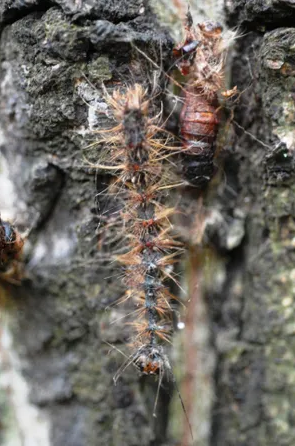War in the skies: Ohio Department of Agriculture uses aircraft to target spongy moths

Spongy moths have voracious appetites. Their feast of choice? Innocent plants. They can defoliate more than 300 kinds of trees and shrubs.
"The caterpillars are kind of the definition of 'The Very Hungry Caterpillar,' that book we read when we were kids," said Jonathan Shields, who manages the Ohio Department of Agriculture's spongy moth program. "They eat and eat leaves, and they can completely strip trees bare when their populations are high."
To combat the invasive species' destruction, Ohio has resorted to aerial attack.
On June 14 and 15, the ODA sent yellow aircraft out above treetops in eight counties. The aircrafts carried a substance called SPLAT GM-O, which was dropped into the counties. SPLAT GM-O does not kill spongy moths, but it does disrupt their mating cycles.
"It's a non-lethal treatment, but it takes advantage of their own biology and uses it against them," Shields said.
The treatments were implemented in the following municipalities:
Delaware County (Olive Green, Sunbury)
Guernsey County (Caldwell North)
Knox County (Centerburg, Homer)
Licking County (Newark)
Muskingum County (Crooksville)
Putnam County (Ottoville)
Vinton County (Mineral)
Washington County (Fleming)
The ODA tracks spongy moth populations throughout the state.
"Those areas that we focused our treatments on this year are areas where tracking has shown that the population is growing quickly," Shields said.
Why the need for population control?
For one, spongy moths' leaf attacks can be lethal.
“Generally, a tree can withstand one defoliation in a year," said Brian Heath, district manager for Davey Tree's east Columbus branch. "But if that were to happen twice over the course of two years, that could potentially kill a tree. They only have so much energy stored to reproduce those leaves.”
Tree deaths have ripple effects for other forms of wildlife, like squirrels, deer and birds. Also, since leaves provide shade, their absence can throw off water temperatures.
Additionally, spongy moths can have an unpleasant consequence for people.
“As all these caterpillars are eating and eating these trees overhead, obviously they’re producing waste, too," Shields said. "So you can have what is essentially bug poop raining down on you, and it makes being outdoors a pretty disgusting thing to take on.”
More: 4 invasive species the Ohio Department of Agriculture is worried about
How to identify, report spongy moths in caterpillar, moth stages
Spongy moths are easiest to identify in caterpillar stage, Shields said. Red and blue dots line their backs, and little spines stick out.
In moth stage, they can range from whitish-brown to truly brown. In egg form, they are tan-colored and spongy to the touch.
Of the 88 counties in Ohio, 51 are under spongy moth quarantine, including Franklin County. People in quarantined zones are asked to look for spongy moths before traveling to non-quarantined areas.
Those who think they might have encountered a spongy moth can file a sighting report on the ODA website. This can be particularly helpful for the ODA if the sighting occurred in a place not already under quarantined.
JNimesheim@dispatch.com
@JackNimesheim
This article originally appeared on The Columbus Dispatch: Ohio agriculture agency uses aircraft to curb spongy moth reproduction
